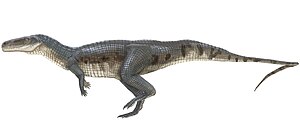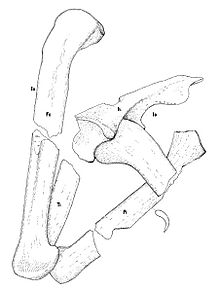Poposaurus
| Poposaurus | ||||||||||||
|---|---|---|---|---|---|---|---|---|---|---|---|---|

Poposaurus , live reconstruction |
||||||||||||
| Temporal occurrence | ||||||||||||
| Upper Triassic ( Carnian to early Norian ) | ||||||||||||
| 235 to 228 million years | ||||||||||||
| Locations | ||||||||||||
| Systematics | ||||||||||||
|
||||||||||||
| Scientific name | ||||||||||||
| Poposaurus | ||||||||||||
| Flour , 1915 | ||||||||||||
| species | ||||||||||||
|
Poposaurus is an extinct genus of archosaurs from the Crurotarsi group thatlived in North Americaduring the Upper Triassic . It is the eponymous representative of the Poposauroidea , a group related to the crocodiles. So far, two species of this genus have been described: the type Poposaurus gracilis and Poposaurus langstoni , the latter originally known as Lythrosuchus . Although traditionally depicted as walking on four legs , recent studies show that it was an obligatory two-legged walking ( bipedal ) animal. Poposaurus is named after the Little Popo Agie River in Wyoming , on the banks ofwhich the first fossils were discoverednear the town of Lander .
Characteristics and bipedia
Poposaurus is estimated to be 4 m long and weigh about 100 kg. Already, (1915) suggested Maurice G. flour that poposaurus ran at least temporarily bipedal ( bipedalism ), although this animal in the following descriptions mostly as a quadruped is shown (on four legs constantly). It was only in 2011 that it was proven that Poposaurus was actually obligatorily biped (necessarily two-legged). This bipede was probably an evolution of the semi-upright gait of its quadruped ancestors, which can still be seen in living crocodiles. The bipedal locomotion of Poposaurus is found in a similar form in dinosaurs . Unlike dinosaurs but its back legs were like a column under the body ( pillar-erect ): So that showed hip socket (acetabulum) down the leg so was like a pillar just below the hip. In dinosaurs, the acetabulum points outwards ( buttress-erect ), with the head of the femur pointing sideways into the acetabulum.
Poposaurus can be distinguished from related genera on the basis of features of the ilium : it has a long and low iliac blade , while the preacetabular process (a forward-facing outgrowth) is shovel-shaped and the post-acetabular process (a rearward outgrowth) was wing-like elongated, similar to theropods .
Finds

Poposaurus was first scientifically described by Maurice G. Mehl in 1915 , based on a fragmentary skeleton ( holotype , copy number CFMNH UR357), which consists of two vertebrae, a caudal vertebra, the left ilium, the upper part of the left thigh bone (femur ), the right thigh bone and the lower part of the seat leg (ischium) consists.
Since the first description, further fragmentary skeletons have been found, mostly consisting of pelvic bones, vertebrae and leg bones. The most complete skeleton to date (copy number YPM 57100) is only missing the skull. The type species Poposaurus gracilis was discovered in the western USA and comes from the Popo Agie Formation of Wyoming , from the Chinle Formation of Arizona and Utah , and from the Tecovas Formation of Texas . The second species, Poposaurus langstoni , comes from the Cooper Canyon Formation in Texas.
Systematics
Internal system
Another species, Poposaurus langstoni , was first described by Long and Murry (1995) as an independent genus - Lythrosuchus . However, a re-description of the Poposaurus fossils revealed that it is believed to be a second species of Poposaurus .
External system
Poposaurus fossils have been known for over 100 years, although the systematic classification was unclear for a long time due to the only fragmentary finds. Thus poposaurus already as ornithischia (Nopcsa, 1921), as Stegosaurus (Huene, 1950) as well as a theropod (Colbert, 1961). Only Walker (1969) realized that it was a pseudosuchid Crurotarsi , an archosaur related to today's crocodiles. More recent specimens of Poposaurus gracilis and other closely related genera confirm the relationship with the Pseudosuchia (Galton, 1977; Long and Murry, 1995; Nesbitt and Norell, 2006; Weinbaum and Hungerbuhler, 2007).
Poposaurus is eponymous representative of the Poposauridae and the Poposauroidea . Both groups are considered identical by many researchers, which is why the name Poposauridae is rarely used. Traditionally, the Poposauroidea is considered a group of the Rauisuchia - current studies suggest, however, that the Rauisuchia are paraphyletic , i.e. do not include all descendants of an ancestor. The relationships within the Poposauroidea are unclear, as possible closer relatives are Shuvosaurus , Sillosaurus and Arizonasaurus .
The following is a recent example of a cladogram from Nesbitt (2011):
| Poposauroidea |
|
||||||||||||||||||||||||||||||||||||||||||
|
|
Web links
Individual evidence
- ↑ Paleobiology Database ( page no longer available , search in web archives ) Info: The link was automatically marked as defective. Please check the link according to the instructions and then remove this notice.
- ^ A b Jacques A. Gauthier , Sterling J. Nesbitt, Emma R. Schachner, Gabe S. Bever, Walter G. Joyce: The bipedal stem crocodilian Poposaurus gracilis: inferring function in fossils and innovation in archosaur locomotion. In: Bulletin of the Peabody Museum of Natural History. Vol. 52, No. 1, 2011, pp. 107-126, doi : 10.3374 / 014.052.0102 .
- ^ A b Maurice G. Mehl: Poposaurus gracilis, a new reptile from the Triassic of Wyoming. In: The Journal of Geology. Vol. 23, 1915, pp. 516-522, JSTOR 30067173 .
- ↑ Emma R. Schachner, Phillip L. Manning, Peter Dodson : Pelvic and hindlimb myology of the basal archosaur Poposaurus gracilis (archosauria: Poposauroidea). In: Journal of Morphology. Vol. 272, No. 12, 2011, pp. 1464-1491, doi : 10.1002 / jmor.10997 .
- ↑ a b c d e f Jonathan C. Weinbaum, Axel Hungerbühler: A revision of Poposaurus gracilis (Archosauria: Suchia) based on two new specimens from the Late Triassic of the southwestern USA In: Paläontologische Zeitschrift . Vol. 81, No. 2, 2007, pp. 131-145, doi : 10.1007 / BF02988388 .
- ↑ a b c d e Sterling J. Nesbitt: The early evolution of archosaurs: relationships and the origin of major clades (= Bulletin of the American Museum of Natural History. No. 352). American Museum of Natural History, New York NY 2011, doi : 10.1206 / 352.1 .
- ^ Robert A. Long, Phillip A. Murry: Late Triassic (Carnian and Norian) Tetrapods from the Southwestern United States (= New Mexico Museum of Natural History & Science. Bulletin. 4, ISSN 1524-4156 ). New Mexico Museum of Natural History and Science, Albuquerque NM 1995, digitized .
- ↑ Stephen L. Brusatte, Michael J. Benton , Julia B. Desojo, Max C. Langer: The higher-level phylogeny of Archosauria (Tetrapoda: Diapsida). In: Journal of Systematic Palaeontology. Vol. 8, No. 1, 2010, pp. 3-47, doi : 10.1080 / 14772010903537732 .
